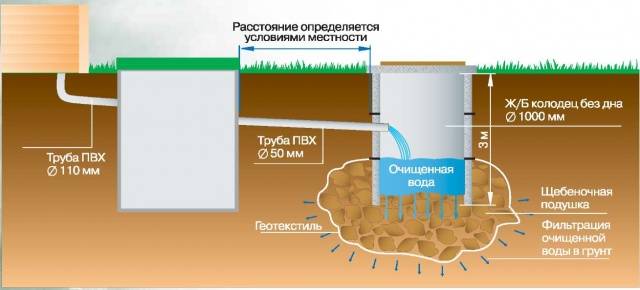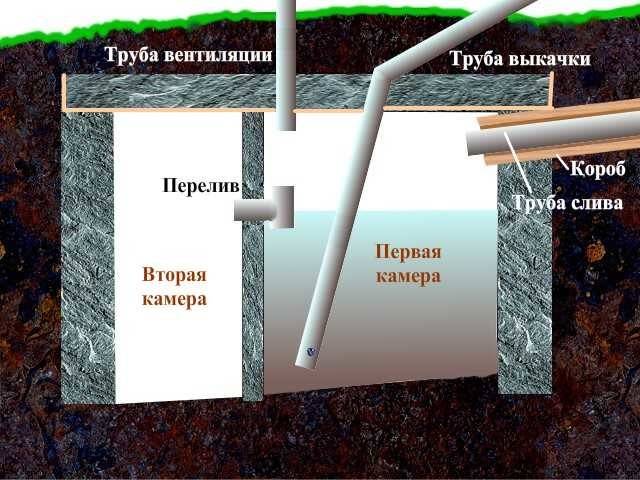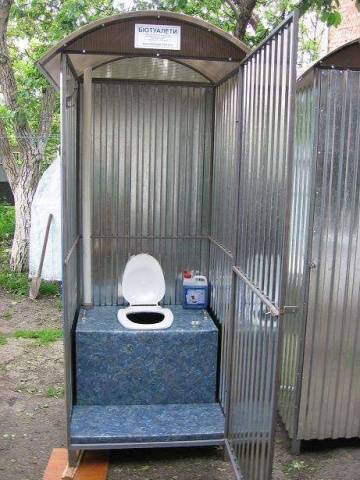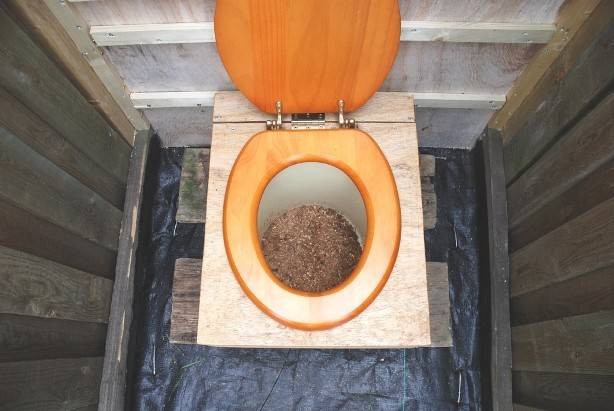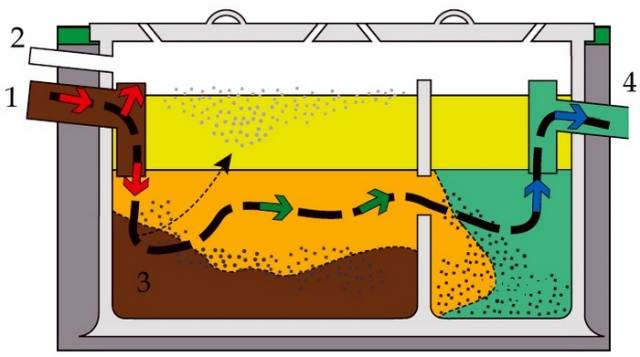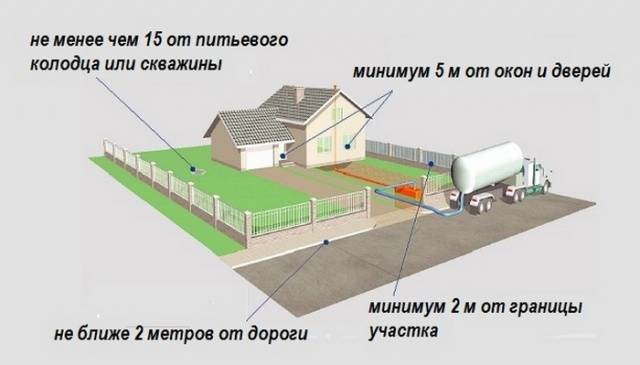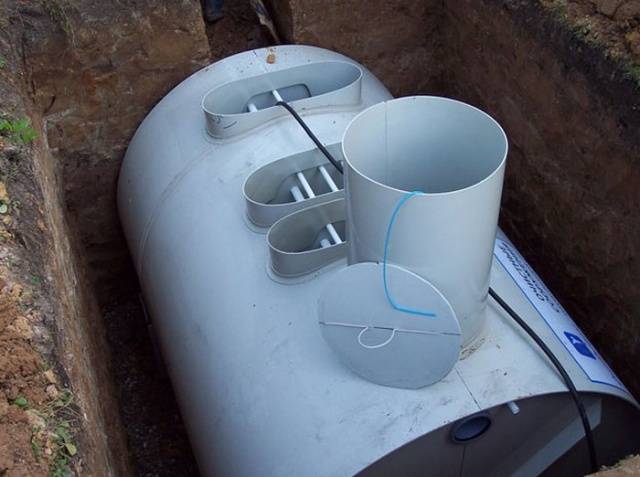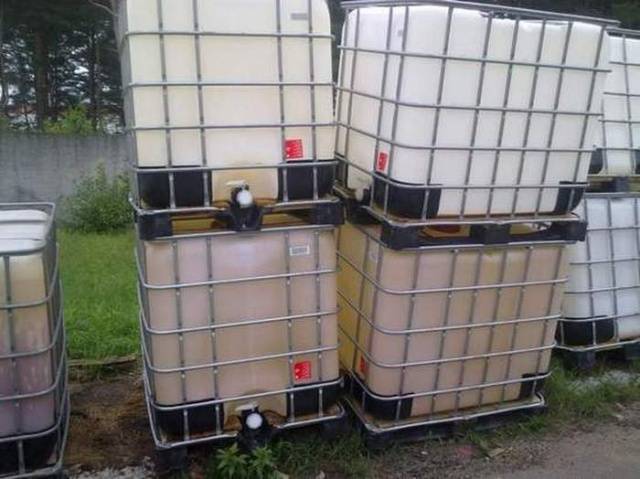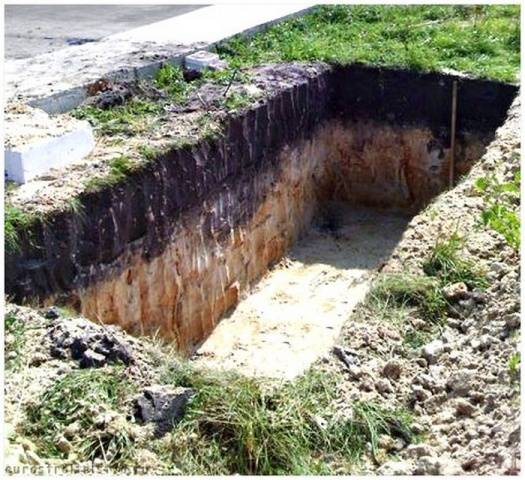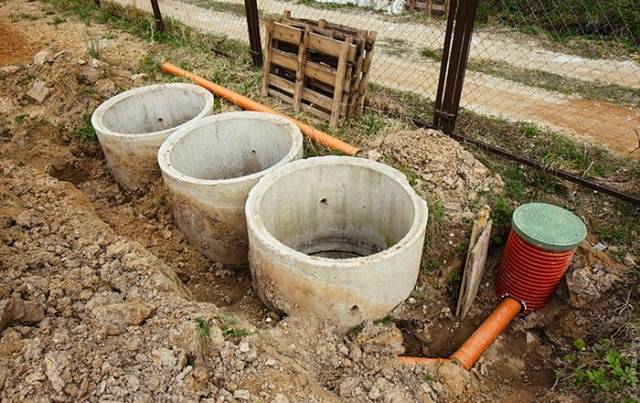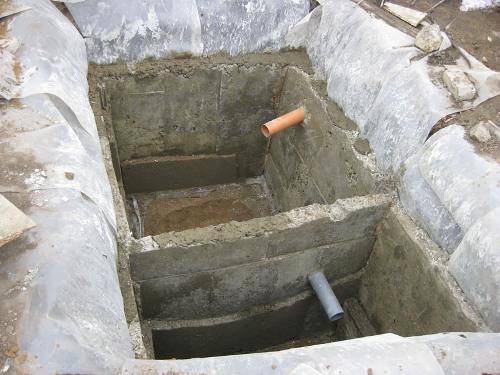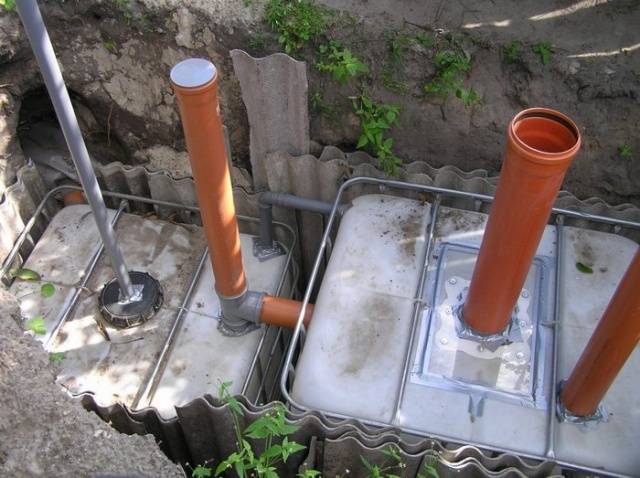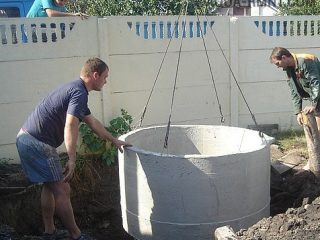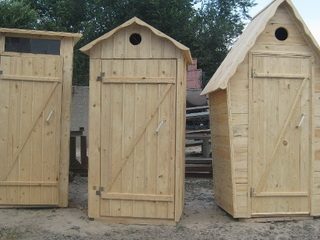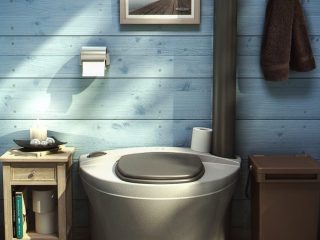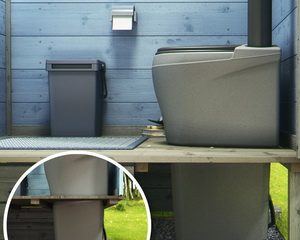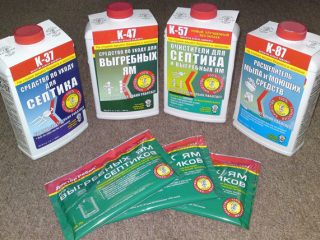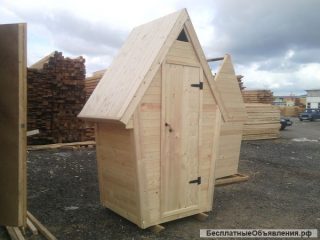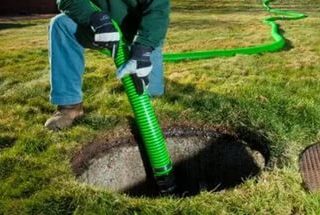Content
- 1 Options for septic tanks for summer cottages
- 2 Construction of a septic tank for a toilet at the dacha
- 2.1 Requirements for a septic tank
- 2.2 Installation location
- 2.3 Camera installation depth
- 2.4 Calculation of chamber volume
- 2.5 What to make cameras from
- 2.6 Digging a pit to install cameras
- 2.7 Construction of a septic tank from reinforced concrete rings
- 2.8 Chambers made of monolithic concrete
- 2.9 Manufacturing of chambers from Eurocubes
- 3 Conclusion
If people will live at the dacha all year round or stay from early spring to late autumn, in addition to an outdoor toilet, it is desirable to install a water closet in the house. The toilet is connected to the sewer system, and the waste is collected in a storage tank. The inconvenience of using the system is the frequent cleaning of the cesspool, because a large volume of water is drained along with feces. An installed septic tank for a toilet in a dacha will save the owner from pumping out sewage and bad smells in the yard.
Options for septic tanks for summer cottages
In terms of its functionality, a septic tank can be called a toilet without bad odors and pumping. You can independently organize different versions of such structures at your dacha.
Homemade overflow septic tank
The name already suggests that something will overflow inside the septic tank. And so it is. An overflow septic tank is an advanced wastewater treatment system. It consists of several chambers, the number and volume of which are calculated according to the number of people living in the dacha.All sewer lines coming from the toilet and water points are connected to the septic tank.
The septic tank operates on the principle of multi-stage cleaning. Sewage through the sewer pipe enters the first chamber - the sump. Waste is broken down into liquid and solid fractions. The sludge settles at the bottom of the first chamber, and the water flows through the overflow pipe into the next chamber, where it is further purified. For septic tanks with three chambers the process is repeated. That is, the liquid from the second chamber through the overflow pipe enters the third tank. No matter how many chambers the septic tank has, the purified liquid from the last tank is drained through drainage pipes to the filtration field, where the final stage of purification and absorption into the soil takes place.
A country septic tank can be bought ready-made or assembled from scrap materials. Any containers, reinforced concrete rings will do, and the chambers can be made monolithic from concrete. The main requirements for tanks are 100% tightness.
Dry toilet instead of septic tank
If it is not possible to install a septic tank, but you want to make a toilet in your dacha without bad odors and frequent pumping, you can pay attention to a dry toilet. The principle of decomposition of sewage occurs similarly in only one container.
The dry closet consists of a separate cubicle.It is usually made from lightweight materials, such as plastic or corrugated sheets. The booth is easy to move from place to place and can be installed on a temporary or permanent base. The role of storage capacity is played by a plastic tank with a volume of up to 250 liters. A disinfectant is introduced into the tank to help process the waste.
The bio-toilet at the dacha will work even in winter at sub-zero temperatures. Improved models are equipped with an autonomous drain tank. Its internal mechanism independently mixes the disinfectant liquid with water every time it drains.
A dry closet installed at the dacha will play the role of a mini-septic tank. The only inconvenience is its more frequent maintenance.
Dry mini-septic tank
If you visit your dacha very rarely, it is unwise to build a large septic tank. A good option for organizing an outdoor toilet would be to install a powder closet. The waste, as in a real septic tank, will be processed into organic fertilizer. The output will be compost for the garden. The powder closet is a toilet seat with storage. It can be installed in an outdoor booth in the country or inside the house.
After visiting the toilet, the waste is sprinkled with peat. In the process, they are processed into compost. In homemade powder closets, powder is applied manually with a scoop. Store structures are equipped with an additional peat tank with a spreading mechanism.
Construction of a septic tank for a toilet at the dacha
You can build a septic tank for a toilet at your dacha with your own hands from ready-made containers, reinforced concrete rings or concrete. Now we will look at the basic design requirements, as well as construction options from different materials.
Requirements for a septic tank
A septic tank is a complex structure, and its performance depends on compliance with the following requirements:
- Single-chamber mini-septic tanks are unable to process waste efficiently. Only multi-stage wastewater treatment, which occurs in at least two chambers, is effective. A three-chamber septic tank is considered the best option for a dacha with frequent visits.
- It is important to ensure that the settling tank and processing chambers are completely sealed. If the dacha is located on loose soil, it is permissible to make the last chamber leaky. To do this, a drainage bottom is paved from sand and crushed stone. Part of the purified water will be absorbed into the soil through the filter pad.
When using a septic tank at your dacha in winter, you need to ensure that the chambers are well insulated. Otherwise, liquid waste will freeze in severe frosts.
Installation location
Despite the fact that a septic tank is a sealed system for collecting and processing sewage, there are sanitary rules for it that determine the installation location:
- the septic tank is located no closer than 3 m from sheds and other outbuildings;
- maintain a distance of 2 m from the road and neighboring boundaries;
- The septic tank should not be brought closer than 5 m to the house, but it is not recommended to remove it further than 15 m due to the increased costs of constructing a sewer pipeline;
- The septic tank is removed 15 m from any source of water.
Compliance with sanitary standards will save the owner of the dacha from unexpected problems in the future.
Camera installation depth
Before choosing a container for a septic tank, you need to find out the depth of groundwater. If the dacha plot is located in a non-flooded area, and the groundwater layers are somewhere deep in the ground, it is wise to choose a vertical installation of cameras. The container is small in diameter but long in length and is buried deep in the ground.In this case, the volume of the chamber is not lost, and space on the summer cottage is saved.
If the groundwater level is high, preference is given only to horizontal laying of the container, since it will not be possible to dig a deep pit. The larger the chamber, the larger its dimensions, which means that in a horizontal position the container will occupy an impressive part of the land plot.
Calculation of chamber volume
In complex sewer systems, the volume of septic tank chambers is calculated taking into account many indicators. For the dacha option, it is enough to follow a simple scheme. An example of a calculation can be taken from the table.
The job of a septic tank is to process sewage for three days. During this time, bacteria manage to break down waste into sludge and water. The volume of the chambers is calculated taking into account all the people living in the dacha. Each person is allocated 200 liters of water consumption per day. The water consumption of all household appliances and water points is also added here. All results are summed up and multiplied by 3. The result is an approximate volume of sewage for three days. However, cameras cannot be selected end to end based on volume. It is better to provide a small reserve.
What to make cameras from
When building a septic tank, you can take the easy route and buy a ready-made installation. Plastic containers have proven themselves well in making cameras independently. Eurocubes are best suited, as they have a ready-made tray and a protective metal grid. It is undesirable to use iron barrels for cameras due to rapid corrosion of the metal.
Reliable septic tank chambers are considered to be structures made of reinforced concrete rings and monolithic concrete. However, their installation is very labor-intensive, and in the case of reinforced concrete rings, you will need to hire lifting equipment.
Digging a pit to install cameras
Having chosen the location of the septic tank on the dacha plot, they begin excavation work. It is better to dig manually with a shovel. This will be more difficult to do, but the foundation pit will have smooth walls of the required size. The dimensions of the pit depend on the size of the chamber. In this case, reserves are made for arranging the bottom and side walls.
You will have to dig exactly as many pits as there will be chambers in the septic tank. Earthen partitions are left between the pits. Their width depends on the terrain conditions, but preferably no more than 1 m. A trench is dug in the partitions for laying an overflow pipe. Another trench is dug from the first chamber of the septic tank towards the house to lay the sewer pipeline.
The bottom of the finished pit is leveled, compacted and covered with a sand cushion 200 mm thick. Further arrangement depends on the selected material for the manufacture of cameras.
Construction of a septic tank from reinforced concrete rings
To make cameras, it is advisable to purchase reinforced concrete rings with locks on the ends. They do not need to be additionally sewn with staples, and the result is a stable structure. First, a ring with a bottom is lowered into the pit. If you cannot find one, you will first have to concrete a 150 mm thick area in the pit. After installing the first ring, all the others are placed on top of each other. The finished chamber is covered with a concrete slab.
When all the chambers are made in this way, holes are punched in the rings with a punch for connecting overflow pipes, sewerage and drain pipes.A ventilation pipe is led out of each chamber through the lid from above. It is connected through a tee to an overflow pipe. The finished septic tank chambers are sealed, covered with waterproofing mastic, insulated and backfilled with soil.
Chambers made of monolithic concrete
To make chambers from monolithic concrete, the bottom and walls of the pit are covered with waterproofing material. Thick polyethylene or roofing felt will do. Along the entire perimeter of the pit, a reinforcing mesh with a cell size of 100x100 mm is knitted from reinforcement 10 mm thick.
The bottom is concreted first, pouring a solution 150 mm thick. After it hardens, formwork is built around the perimeter of the walls of the pit. Concrete is poured inside the resulting niches with reinforcing mesh.
When the concrete chambers gain strength, which will be in about 1 month, they begin further arrangement of the septic tank. Installation of overflow pipes, covers and all other work is the same as for chambers made of reinforced concrete rings.
Manufacturing of chambers from Eurocubes
For Eurocubes, the bottom of the pits is made in steps with an offset of 200 mm relative to each other. Installing cameras at different heights allows you to save their useful volume. The bottom of the pit is pre-concreted, leaving protruding metal loops. Eurocubes are lowered into the pit along with pallets. To prevent plastic tanks from pushing groundwater out of the ground, they are tied with cables to the anchor loops left on the concrete bottom.
Further work consists of cutting holes in the walls of the Eurocubes with a jigsaw to connect the pipes. The connection of air ducts, overflow pipes, drainage and sewerage is carried out according to a similar scheme as for a septic tank made of rings.
The outside of the Eurocubes is insulated with polystyrene foam and covered with PET film on top.To prevent earth pressure from crushing the chambers, a casing is made around the containers. You can use slate, boards or other building material. When the work is completed, the soil is backfilled.
The video shows the manufacture of a septic tank:
Conclusion
A septic tank will save the owner of a dacha from many of the problems that a simple street toilet can cause. The main thing is to introduce bacteria into the chambers in a timely manner and periodically clean the sump.
